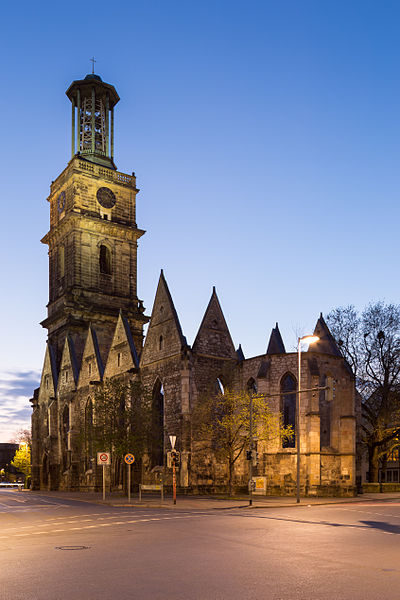Bombing of Hanover in World War II
The aerial bombings of Hanover are a series of eighty-eight air raids by Royal Air Force (RAF) Bomber Command and the United States Army Air Forces (USAAF) on the German city of Hanover during World War II. Collectively these air raids killed 6,782 persons, predominantly civilian residents. Around 1,000 aerial mines, 34,000 high explosive bombs, 900,000 incendiary bombs and 50,000 fire bombs were dropped. The most destructive and deadly air raid on Hanover was conducted by the RAF on the night beginning 8 October 1943, killing 1,245 persons, and is an example of carpet bombing of suburban and residential civilian targets laid out in the Area Bombing Directive of 14 February 1942.
Hanover city centre in 1945, photographed from northwest by Margaret Bourke-White travelling through Germany with the USAAF and General Patton. The Market Church at the centre of the historic old town of, at the time, half-timbered buildings is just off the centre of the photograph.
The Deurag-Nerag refineries at the end of the war
In 1952 Aegidien Church became a war memorial dedicated to victims of war and of violence.
Interior of the Old Town Hall in 1943
Aegidien Church, after Saint Giles to whom the church was dedicated, is a war memorial in Hanover, the capital of Lower Saxony, Germany. The church dates from 1347, when it replaced an older Romanesque church dating to 1163. This in turn replaced an even earlier chapel. Aegidien Church was destroyed during the night beginning 8 October 1943 by aerial bombings of Hanover during World War II. In 1952, Aegidien Church became a war memorial dedicated to victims of war and of violence.
As seen from south-east, across the traffic lights at the intersection of Breite Strasse and Osterstrasse
View from west, c. 1910
Humility (Demut) by Kurt Lehmann
Peace bell on 6 August 2014, with mayor Stefan Schostok and superintendent Thomas Höflich








